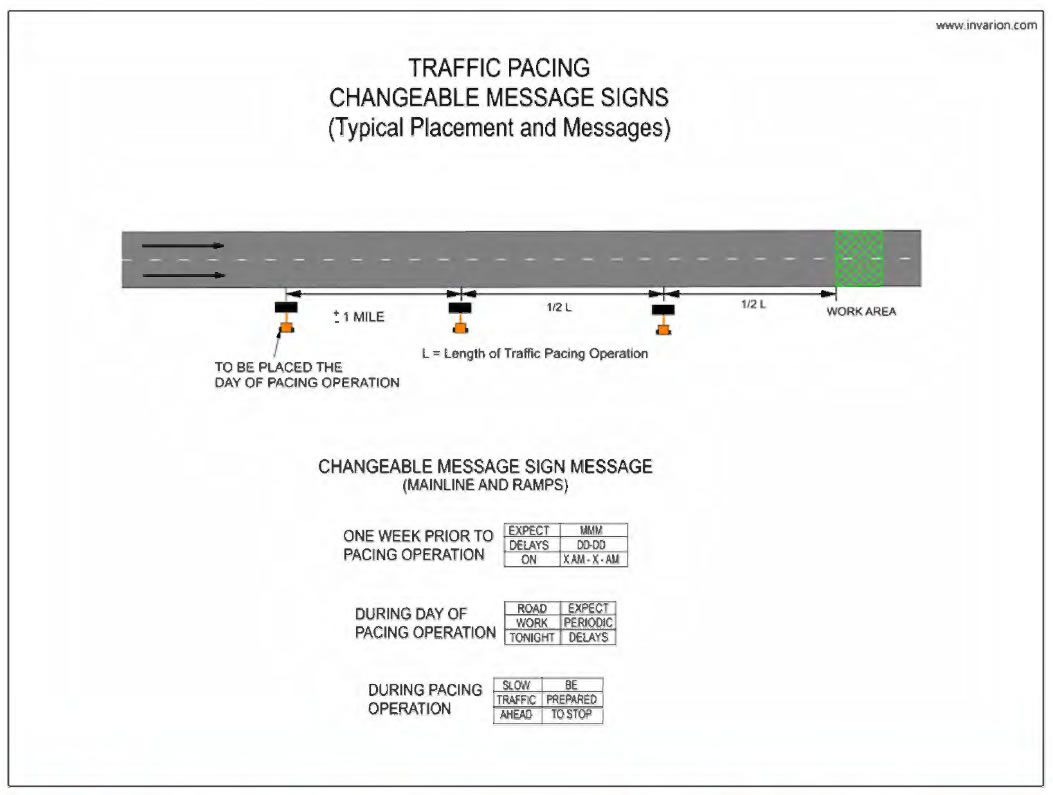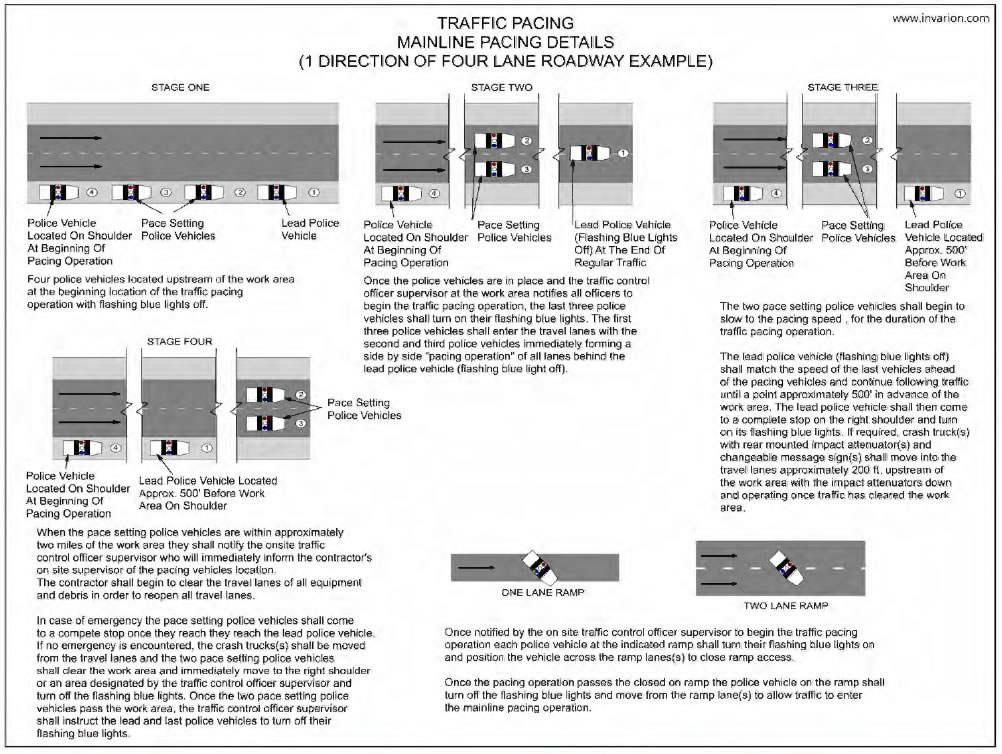Safely Implementing Rolling Roadblocks for Short-Term Road Work
Printable version [PDF 4.6MB]
You may need the Adobe® Reader® to view the PDFs on this page.
Contact Information: Operations Feedback at OperationsFeedback@dot.gov
slide 1
Safely Implementing Rolling Roadblocks for Short-Term Road Work

FHWA Work Zone Management Program
April 23, 2019
slide 2
Webinar Purpose
- Background on Rolling Roadblocks.
- Safely Implementing Rolling Roadblocks.
- Example State Policies for Safely Implementing Rolling Roadblocks.
- Additional Information and Resources.
slide 3
Webinar Speakers
- Jawad Paracha – Federal Highway Administration
- Program Manager – Work Zone Management Program
- Larry Haas – Colorado Department of Transportation
- Traffic Operations Engineer – Northeast Region
- Dan Smith – Missouri Department of Transportation
- Traffic Management and Operations Engineer
slide 4
What is a Rolling Roadblock?
slide 5
Rolling Roadblocks
- Also referred to as traffic breaks, temporary road closures, pacing operations, or traffic pacing.
- Temporary Traffic Control (TTC) technique to temporarily slow or stop traffic in order to provide a gap in the flow of traffic in advance of downstream road work activities.
 Source: Raleigh News and Observer
Source: Raleigh News and Observer
slide 6
Rolling Roadblocks (Continued)
- Enables the completion of short-term road work where a long-term closure using standard TTC is not needed:
- Bridge construction and replacement.
- Placing and removing overhead lights or sign structures.
- Overhead utility work.
- Blasting for rock excavation.
- Allows for faster completion of road work activities by allowing workers full access on and above a roadway, and a safer work environment by completely removing vehicles that would normally be in close proximity to workers.
 Source: ATSSA
Source: ATSSA
slide 7
Rolling Roadblocks (Continued)
Highly effective TTC technique, but…
The use of rolling roadblocks for short-term road work activities can pose safety hazards to the traveling public if not implemented safely.
slide 8
Safely Implementing Rolling Roadblocks
slide 9
Rolling Roadblock Policies
- A recent scan of State DOT usage of rolling roadblocks and associated policies found:
- 23 of 28 responding agencies use rolling roadblocks.
- Of the 23 States using rolling roadblocks, 16 do so routinely, but five of those States do not have policies governing their use.
- More than 40% of responding States that use rolling roadblocks do not have standard policies or procedures for their implementation.
- As a best practice, transportation agencies are encouraged to have policies and procedures in place for the safe use of rolling roadblocks.
slide 10
Rolling Roadblock Policies (Continued)
- Policies and procedures governing the use of rolling roadblocks vary by State.
- Policies should be documented in a project's Transportation Management Plan (TMP) and specifications, and in every encroachment permit involving a roadblock in the State.
 Source: KYTC
Source: KYTC
slide 11
Best Practices for Rolling Roadblocks
Establishing a rolling roadblock policy:
- Specify the type of work activities, times of day, and days of the week where the use of rolling roadblocks are permitted and/or required, and clearly detail these points in TTC plans and/or technical specifications.
- Require the development of an emergency plan to handle traffic should unforeseen circumstances occur.
- Specify whether the policy varies if the work is being performed by a contractor or the agency's own employees.
slide 12
Best Practices for Rolling Roadblocks (Continued)
Prior to the start of a rolling roadblock:
- Require an advance planning meeting with all stakeholders to define responsibilities and ensure activities required for successfully executing a rolling roadblock will be completed, including notifying fire stations and other emergency response agencies.
- Require a final meeting among stakeholders before the rolling roadblock is executed to ensure all requirements have been implemented.
slide 13
Best Practices for Rolling Roadblocks (Continued)
Notifying the public prior to the start of a rolling roadblock:
- Require issuing press releases to radio and television stations, newspapers, the agency's website, and agency social media sites.
- Require advising the public in advance as to when the rolling roadblock will be performed, including using:
- Portable changeable message signs (PCMS) to display appropriate messages to the public at least a week in advance of the roadblock.
- PCMS on the day of roadblock to alert users that the operation will be happening that day, including the hours during which the roadblocks will occur.
slide 14
Best Practices for Rolling Roadblocks (Continued)
During and after the rolling roadblock:
- Specify appropriate advance warning signing to alert traffic to the downstream presence of a slow or stopped traffic condition.
- Require using any permanent changeable message signs (CMS) boards within the activity area for public notification.
- Considering the use of queue warnings systems to provide drivers with advanced notification of downstream queues.
- Ensure that traffic queue formations and their dispersals are monitored.
- Ensure that a rolling roadblock not be started until traffic from a preceding rolling roadblock has been cleared.
slide 15
Colorado Department of Transportation's Use of Rolling Roadblocks
Larry Haas – Traffic Operations Engineer
slide 16
I-70

slide 17
I-76

slide 18

slide 19

slide 20

slide 21
Colorado Contact
Larry Haas
CDOT Region 4
Traffic Operations Engineer
Larry.Haas@state.co.us
slide 22
Missouri Department of Transportation Traffic Pacing Worksheet
Dan Smith – Traffic Management and Operations Engineer
slide 23
Traffic Pacing/Rolling Roadblock
- Before 2013, Missouri DOT did not have traffic pacing guidelines.
- MoDOT's Southwest District reviewed several states guidance for traffic pacing.
- Florida DOT had design standards for traffic pacing.
- MoDOT Southwest District developed an excel spreadsheet to calculate the pacing speed, pacing length, max. queue, total work time allowed, and hours allowed to work.
slide 24

slide 25
Locating Traffic Pacing Worksheet

616.13 Work Zone Capacity, Queue and Travel Delay
616.13.7 Traffic Pacing
http://epg.modot.org/index.php/616.13_Work_Zone_Capacity,_Queue_and_Travel_Delay
slide 26
Step No 1

slide 27

slide 28

slide 29

slide 30

slide 31

slide 32

slide 33

slide 34

slide 35

slide 36

slide 37

slide 38
Traffic Pacing
- Traffic pacing worksheet provides information (work duration, pacing speed, work hours, etc.) to develop an operation plan.
- MoDOT districts work with many partners (newspapers, radio, contractor, utilities, law enforcement, etc.) to prepare for traffic pacing operation.
- Communication and coordination is critical.
slide 39
Missouri Contacts
Daniel Smith
Traffic Management & Operations
Engineer
573-526-4329
daniel.smith@modot.mo.gov
Nick Voltenburg
Intermediate Traffic Studies
Specialist
573-751-1097
nickolas.voltenburg@modot.mo.gov
Ashley Buechter
Traffic Liaison Engineer
573-751-0982
ashley.buechter@modot.mo.gov
slide 40
Additional Information and Resources
slide 41
Guidelines on Rolling Roadblocks for Work Zone Applications
- Establishes best practices in the use of rolling roadblocks:
- Planning and coordinating a rolling roadblock.
- Executing a rolling roadblock.
- Developing a rolling roadblock planning checklist.
https://www.workzonesafety.org
slide 42
Additional Resources
slide 43
Additional Resources (Continued)
slide 44
Contacts
slide 45
Questions





















